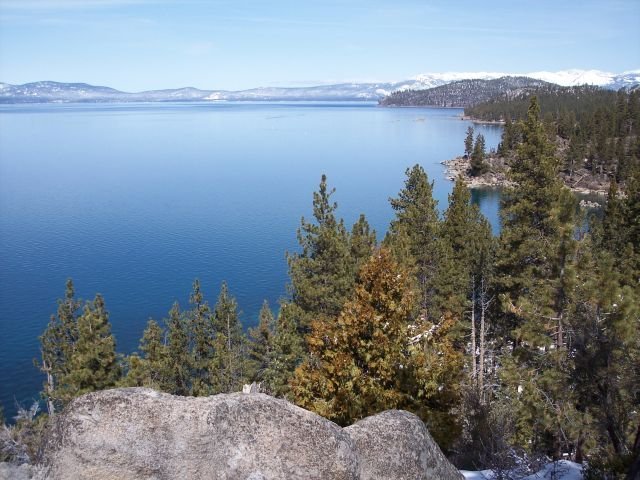Lake Tahoe, renowned for its crystal-clear waters and stunning alpine scenery, offers a unique underwater world for scuba diving enthusiasts. Diving to the bottom of Lake Tahoe presents challenges and rewards, with depths reaching over 1,600 feet in some areas. The lake’s exceptional clarity, often exceeding 100 feet of visibility, allows divers to explore sunken vessels, underwater cliffs, and diverse aquatic life. However, the extreme depth and cold temperatures require advanced diving skills and specialized equipment.
What Makes Lake Tahoe Unique for Diving?

Lake Tahoe’s underwater landscape is as diverse and captivating as its surrounding mountains. The lake’s exceptional clarity, often surpassing 100 feet of visibility, provides divers with an unparalleled underwater experience. This clarity is attributed to the lake’s high altitude, low algae content, and the surrounding granite basin that filters incoming water.
Key features that make diving in Lake Tahoe unique include:
- Exceptional water clarity
- Diverse underwater topography
- Sunken historical artifacts
- Challenging deep-water diving opportunities
- Unique alpine lake ecosystem
What Are the Challenges of Diving to the Bottom of Lake Tahoe?

Diving to the bottom of Lake Tahoe is not for the faint of heart. The lake’s extreme depth, reaching over 1,600 feet at its deepest point, presents significant challenges:
-
Extreme Depth: Most of Lake Tahoe’s bottom is beyond the reach of recreational divers. Technical diving skills and equipment are necessary for exploring the deepest areas.
-
Cold Water: Even in summer, water temperatures can drop to near-freezing at depth. Proper thermal protection, such as drysuits, is essential.
-
Altitude: Lake Tahoe’s high elevation (6,225 feet above sea level) affects decompression calculations and increases the risk of decompression sickness.
-
Limited Bottom Time: Due to the depth and cold, divers have very limited time at the bottom, requiring careful planning and execution.
-
Specialized Equipment: Deep diving in Lake Tahoe requires technical diving gear, including mixed gases and rebreathers for extended bottom times.
What Can Divers Expect to See at the Bottom of Lake Tahoe?
While reaching the absolute bottom of Lake Tahoe is beyond the scope of most divers, exploring the deeper areas accessible to technical divers reveals a fascinating underwater world:
- Ancient submerged forests
- Geological formations like underwater canyons and cliffs
- Potential archaeological sites from prehistoric times
- Unique deep-water organisms adapted to the cold, dark environment
For those unable to reach extreme depths, Lake Tahoe still offers incredible diving experiences at more accessible depths:
| Depth Range | Features |
|---|---|
| 0-60 feet | Sunken boats, barges, and artifacts in Emerald Bay |
| 60-100 feet | Boulder fields, vertical cliffs at Sand Harbor |
| 100-300 feet | Steep drop-offs, ledges at Rubicon Wall |
| 300+ feet | Deep water environment (technical diving only) |
How Do Divers Prepare for Deep Dives in Lake Tahoe?
Preparing for deep dives in Lake Tahoe requires extensive planning and expertise:
-
Training: Advanced certifications in technical diving, including mixed gas and decompression procedures.
-
Equipment: Specialized gear such as:
- Drysuits for thermal protection
- Multiple tanks or rebreathers for extended bottom time
-
Dive computers capable of altitude and mixed gas calculations
-
Dive Planning: Careful consideration of:
- Decompression schedules
- Gas management
-
Emergency procedures
-
Physical Fitness: Deep diving is physically demanding, especially in cold water at altitude.
-
Local Knowledge: Familiarity with Lake Tahoe’s specific conditions and dive sites is crucial.
What Are the Best Dive Sites for Exploring Lake Tahoe’s Depths?
While the deepest parts of Lake Tahoe are inaccessible to most divers, several sites offer opportunities to experience the lake’s depth and unique features:
- Rubicon Wall
- Location: Southwest side of Lake Tahoe
- Depth: Drops to 1,000 feet (300 meters)
-
Features: Sheer cliffs, ledges, and dramatic topography
-
Sand Harbor
- Depth: Slope begins at 40 feet, descending to hundreds of feet
-
Features: Giant boulders, vertical cliffs, diverse marine life
-
Emerald Bay Maritime Heritage Trail
- Depth: 10 to 60 feet (3 to 18 meters)
- Features: Historic shipwrecks and artifacts
What Unique Marine Life Can Be Found in Lake Tahoe’s Depths?
Lake Tahoe’s ecosystem, while not as diverse as ocean environments, hosts several interesting species:
- Lahontan cutthroat trout (native species)
- Kokanee salmon (introduced species)
- Crawfish
- Freshwater sponges
- Various species of minnows and small fish
In the deepest parts of the lake, life becomes scarce due to cold temperatures and high pressure. However, researchers have found microbial life even at extreme depths.
What Safety Precautions Are Essential for Deep Diving in Lake Tahoe?
Safety is paramount when diving to the bottom of Lake Tahoe:
-
Dive with a Buddy: Never dive alone, especially in deep water.
-
Use Dive Flags: Essential to alert boats of your presence.
-
Monitor Decompression: Use dive computers and follow conservative profiles.
-
Carry Redundant Equipment: Backup air sources, lights, and critical gear.
-
Know Your Limits: Don’t exceed your training or experience level.
-
Understand Altitude Effects: Adjust dive plans for Lake Tahoe’s elevation.
-
Be Prepared for Emergencies: Know evacuation procedures and the location of the nearest decompression chamber.
How Has Climate Change Affected Diving Conditions in Lake Tahoe?
Climate change has impacted Lake Tahoe in several ways that affect diving:
-
Water Temperature: Gradual warming of surface waters, potentially affecting thermoclines and marine life distribution.
-
Water Clarity: Changes in precipitation patterns and increased algae growth have reduced water clarity in some areas.
-
Water Levels: Drought conditions have led to lower water levels, affecting access to some dive sites.
-
Ecosystem Changes: Shifts in native species populations and increased presence of invasive species.
Divers exploring Lake Tahoe should be aware of these changes and how they might impact dive planning and underwater experiences.
What Future Discoveries Await in the Depths of Lake Tahoe?
The depths of Lake Tahoe still hold many mysteries:
- Potential archaeological sites from Native American cultures
- Undiscovered shipwrecks or artifacts from early European settlers
- New insights into the lake’s geological history and formation
- Unique adaptations of deep-water organisms to Lake Tahoe’s environment
As diving technology advances, future expeditions may uncover new wonders in the lake’s deepest reaches, providing valuable scientific and historical insights.
Diving to the bottom of Lake Tahoe offers a thrilling adventure for those with the skills and equipment to explore its depths. While the absolute bottom remains out of reach for most, the lake’s underwater world provides a unique and challenging environment for divers to explore, from historic shipwrecks to dramatic underwater cliffs. As with any extreme diving, safety and proper preparation are paramount, ensuring that divers can safely experience the wonders hidden beneath Lake Tahoe’s surface.

